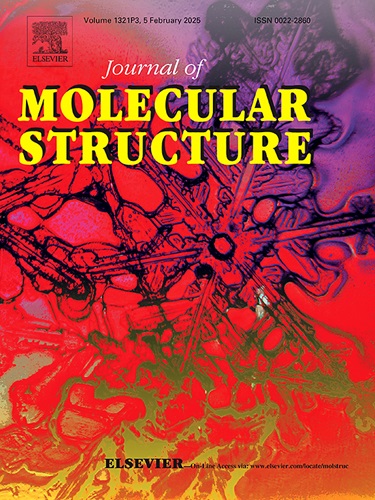N,N-Dimethylaminonaphthyl-modified dicyanoisophorone near-infrared probe for dual-functional imaging of β-amyloid aggregates and lipid droplets
IF 4.7
2区 化学
Q2 CHEMISTRY, PHYSICAL
引用次数: 0
Abstract
Dicyanoisophorone (DCIP)-based compounds, used as fluorescent probes of β-amyloid (Aβ) aggregates, exhibit limitations including a short emission wavelength and insufficient selectivity. To address these issues, we replaced the N,N-dimethylaminobenzene moiety with an N,N-dimethylaminonaphthalene group, leading to the development of a novel derivative, A13. This structural modification not only extends the π-conjugated system, thereby achieving a significantly red-shifted emission, but also improves the binding specificity of the probe for Aβ aggregates. The fluorescence intensity of A13 exhibited a remarkable 35-fold increase upon binding with Aβ aggregates, demonstrating superior performance compared to DCIP (13-fold) and indicating a strong binding affinity, with a dissociation constant (Kd) of 141.5 ± 15.2 nM. Molecular docking simulations were also performed to elucidate the binding mode between A13 and Aβ aggregates. Furthermore, owing to its enhanced lipophilicity, A13 could specifically label intracellular lipid droplets (LDs) and, more importantly, was able to detect real-time visualization of the complete cellular trafficking pathway of FITC-labeled Aβ monomers, including their cellular uptake and subsequent lysosomal delivery mediated by LDs. In vivo experiments showed that A13 effectively crossed the blood–brain barrier in mice, enabling near-infrared imaging of brain tissue. Notably, A13 exhibited distinct fluorescence patterns between wild-type mice and APP/PS1 transgenic models, successfully differentiating their cerebral fluorescence signals. These findings demonstrate that A13 can serve as a dual-functional fluorescent probe capable of detecting both Aβ aggregates and LDs, thus providing a novel tool for early diagnosis and pathological investigation of Alzheimer's disease.

N,N-二甲氨基萘修饰双氰异磷酮近红外探针用于β-淀粉样蛋白聚集体和脂滴的双功能成像
基于双氰异佛酮(DCIP)的化合物作为β-淀粉样蛋白(a β)聚集体的荧光探针,具有发射波长短和选择性不足的局限性。为了解决这些问题,我们用N,N-二甲氨基萘基取代了N,N-二甲氨基苯部分,从而开发了一种新的衍生物A13。这种结构修饰不仅扩展了π共轭体系,从而实现了明显的红移发射,而且提高了探针对a β聚集体的结合特异性。A13与a β聚集体结合后,荧光强度显著提高35倍,与DCIP(13倍)相比表现出更好的性能,表明其具有较强的结合亲和力,解离常数(Kd)为141.5±15.2 nM。分子对接模拟也阐明了A13和Aβ聚集体之间的结合模式。此外,由于其增强的亲脂性,A13可以特异性标记细胞内脂滴(ld),更重要的是,能够实时可视化fitc标记的Aβ单体的完整细胞运输途径,包括它们的细胞摄取和随后由ld介导的溶酶体递送。体内实验表明,A13有效地穿过小鼠血脑屏障,使脑组织近红外成像成为可能。值得注意的是,A13在野生型小鼠和APP/PS1转基因模型之间表现出不同的荧光模式,成功地分化了它们的大脑荧光信号。这些发现表明,A13可以作为一种双功能荧光探针,同时检测a β聚集体和ld,从而为阿尔茨海默病的早期诊断和病理调查提供了一种新的工具。
本文章由计算机程序翻译,如有差异,请以英文原文为准。
求助全文
约1分钟内获得全文
求助全文
来源期刊

Journal of Molecular Structure
化学-物理化学
CiteScore
7.10
自引率
15.80%
发文量
2384
审稿时长
45 days
期刊介绍:
The Journal of Molecular Structure is dedicated to the publication of full-length articles and review papers, providing important new structural information on all types of chemical species including:
• Stable and unstable molecules in all types of environments (vapour, molecular beam, liquid, solution, liquid crystal, solid state, matrix-isolated, surface-absorbed etc.)
• Chemical intermediates
• Molecules in excited states
• Biological molecules
• Polymers.
The methods used may include any combination of spectroscopic and non-spectroscopic techniques, for example:
• Infrared spectroscopy (mid, far, near)
• Raman spectroscopy and non-linear Raman methods (CARS, etc.)
• Electronic absorption spectroscopy
• Optical rotatory dispersion and circular dichroism
• Fluorescence and phosphorescence techniques
• Electron spectroscopies (PES, XPS), EXAFS, etc.
• Microwave spectroscopy
• Electron diffraction
• NMR and ESR spectroscopies
• Mössbauer spectroscopy
• X-ray crystallography
• Charge Density Analyses
• Computational Studies (supplementing experimental methods)
We encourage publications combining theoretical and experimental approaches. The structural insights gained by the studies should be correlated with the properties, activity and/ or reactivity of the molecule under investigation and the relevance of this molecule and its implications should be discussed.
 求助内容:
求助内容: 应助结果提醒方式:
应助结果提醒方式:


